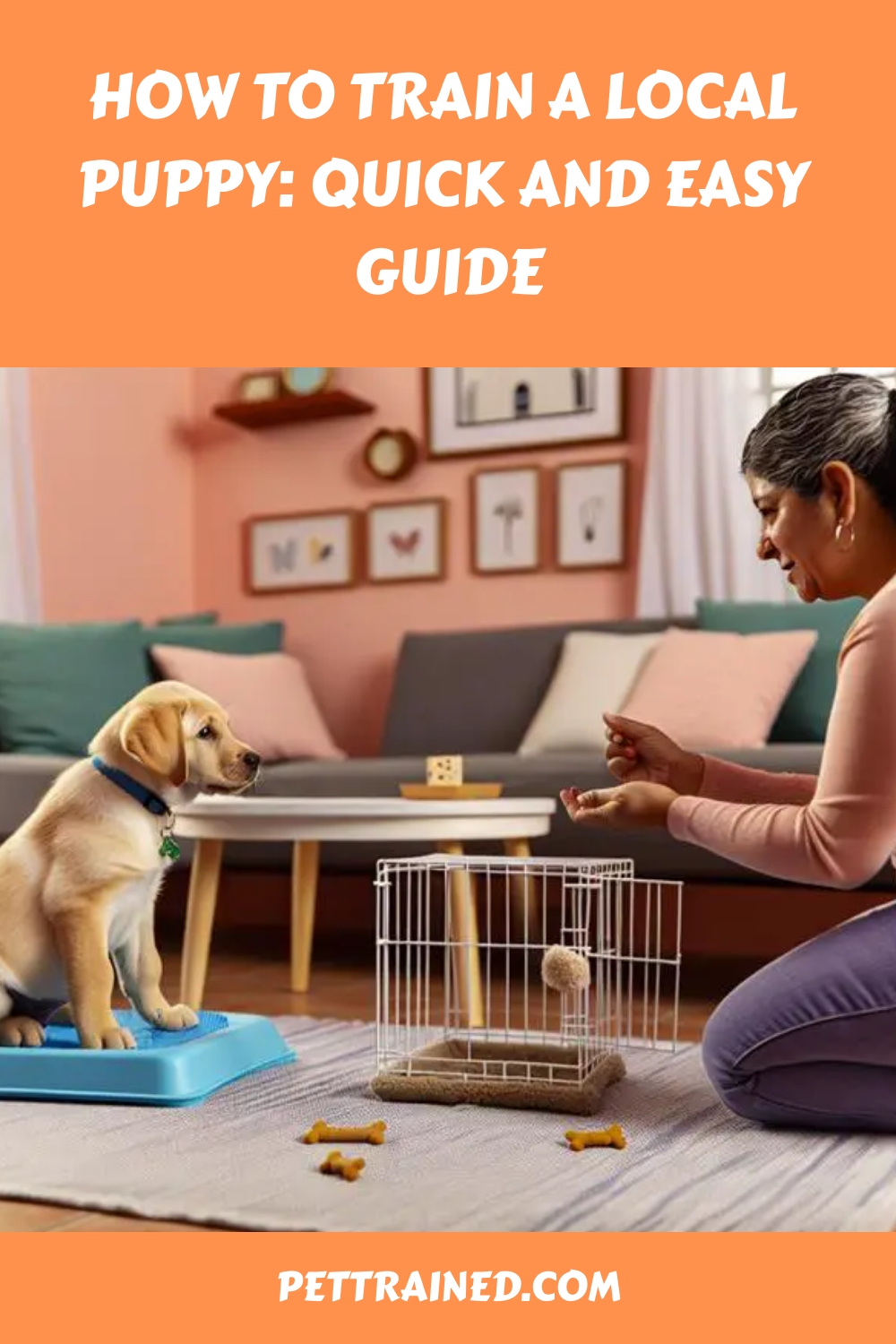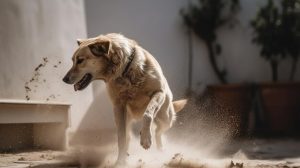To train a local puppy, start by establishing a consistent bathroom routine. Use a specific spot outside and gradually switch from puppy pads.
Feed your puppy on a strict schedule and monitor eating habits. With patience and clicker training, teach basic commands like ‘sit,’ ‘stay,’ and ‘come. ‘ Socialize your puppy by introducing it to varied environments and rewarding good behavior.

Crate training? Pick the right size, create a routine, and use positive reinforcement.
Lastly, ensure plenty of playtime and rest. Follow these steps, and you’ll see great results in your puppy’s training journey. Let’s walk through each step in more detail.
Table of Contents
Housebreaking Your Puppy

To housebreak your puppy effectively, start by establishing a consistent bathroom routine. This will help prevent accidents and make the process smoother.
This post contains affiliate links. However all the information provided on this site are my own honest opinions. See more in Disclaimer.
First, choose a specific spot outside where you want your puppy to do their business. Always take them to this spot, so they associate it with bathroom time.
While your puppy is still learning, you can use puppy pads inside your home. Place these pads in areas where accidents are more likely to happen. This will help contain any messes and make cleanup easier.
Gradually move the pads closer to the door and eventually outside so your puppy starts understanding that outside is the proper place.
Keep an eye on your puppy at all times. Look for signs that it needs to go, such as sniffing around or circling. When you notice these signs, immediately take them to the designated bathroom spot.
Praise and reward them with treats when they successfully go outside. This positive reinforcement will encourage them to repeat the behavior.
Establishing a Routine
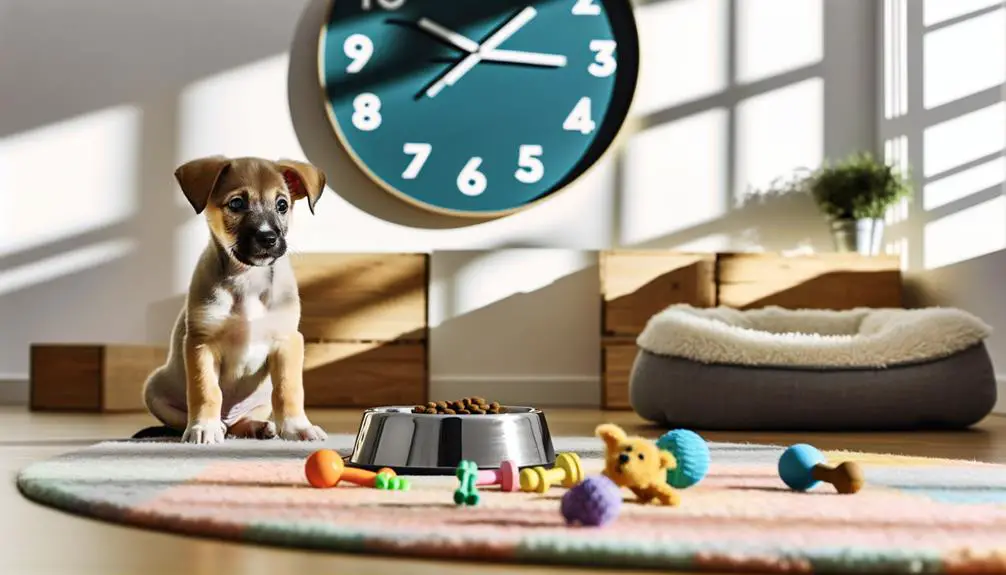
To establish a routine, start by setting a consistent feeding schedule for your puppy. This will help regulate their bathroom habits, making it easier to plan regular bathroom breaks.
Stick to these schedules strictly to create a sense of predictability and stability for your puppy.
Consistent Feeding Schedule
Setting a consistent feeding schedule for your puppy guarantees they develop a healthy routine and balanced diet. Start by making sure proper food portioning based on your puppy’s age, weight, and breed.
Consult your vet to determine the right amount and type of food. Overfeeding or underfeeding can lead to health issues, so it’s important to get this right.
Next, designate a specific feeding location in your home. This helps your puppy associate that area with mealtime, creating a sense of security and routine. It could be a quiet corner in the kitchen or a specific spot in the dining area.
Consistency in the feeding location minimizes distractions and promotes good eating habits.
Here’s how to establish a consistent feeding schedule:
- Set Specific Times: Feed your puppy at the same times every day. Typically, three times a day works well for young puppies.
- Stick to Routine: Don’t deviate from the schedule. Consistency helps regulate your puppy’s digestive system and prevents hunger-related behavioral issues.
- Monitor and Adjust: Observe your puppy’s eating habits and adjust portions and feeding times as they grow. Regularly update your vet on their progress.
Follow these steps to make sure your puppy develops a healthy eating routine.
Regular Bathroom Breaks
Establishing a regular bathroom break routine for your puppy is crucial for successful house training and preventing accidents. Start by taking your puppy outside first thing in the morning, after meals, and before bedtime.
Consistency is key, so try to stick to the same times each day.
When you take your puppy outside, use outdoor supervision to make sure they actually go.
Choose a specific spot in your yard, and wait patiently until they relieve themselves. Praise them enthusiastically and offer a small treat once they’ve finished. This positive reinforcement helps them understand that going outside is the right behavior.
If you’re not able to take your puppy outside frequently, consider using puppy pads indoors.
Place them in a designated area and guide your puppy to them when it’s time for a bathroom break. Gradually move the pads closer to the door until your puppy associates going outside with their bathroom routine.
Teaching Basic Commands

When teaching basic commands, start with ‘sit’ as it’s one of the easiest for your puppy to understand.
Use clicker training to mark the correct behavior. Hold a treat close to your puppy’s nose, then move your hand up, allowing their head to follow the treat and causing their bottom to lower.
Once they’re in the sitting position, say ‘sit,’ click the clicker, and give them the treat.
Next, progress to the ‘stay’ command. Begin by having your puppy sit.
Open your palm in front of their face and say ‘stay.’ Take a step back and if they stay, click the clicker and reward them. Gradually increase the distance and duration.
Finally, teach the ‘come’ command, essential for leash walking. Start with your puppy on a leash.
Gently pull the leash while saying ‘come’ and moving backward. When they follow, click the clicker and give a treat.
Here’s a quick summary to help you:
- Sit: Use a treat to guide them into the position.
- Stay: Use your palm and reward for staying put.
- Come: Use the leash to guide them toward you.
Consistency and patience are key to mastering these commands.
Trending in Dogs:
Socializing Your Puppy
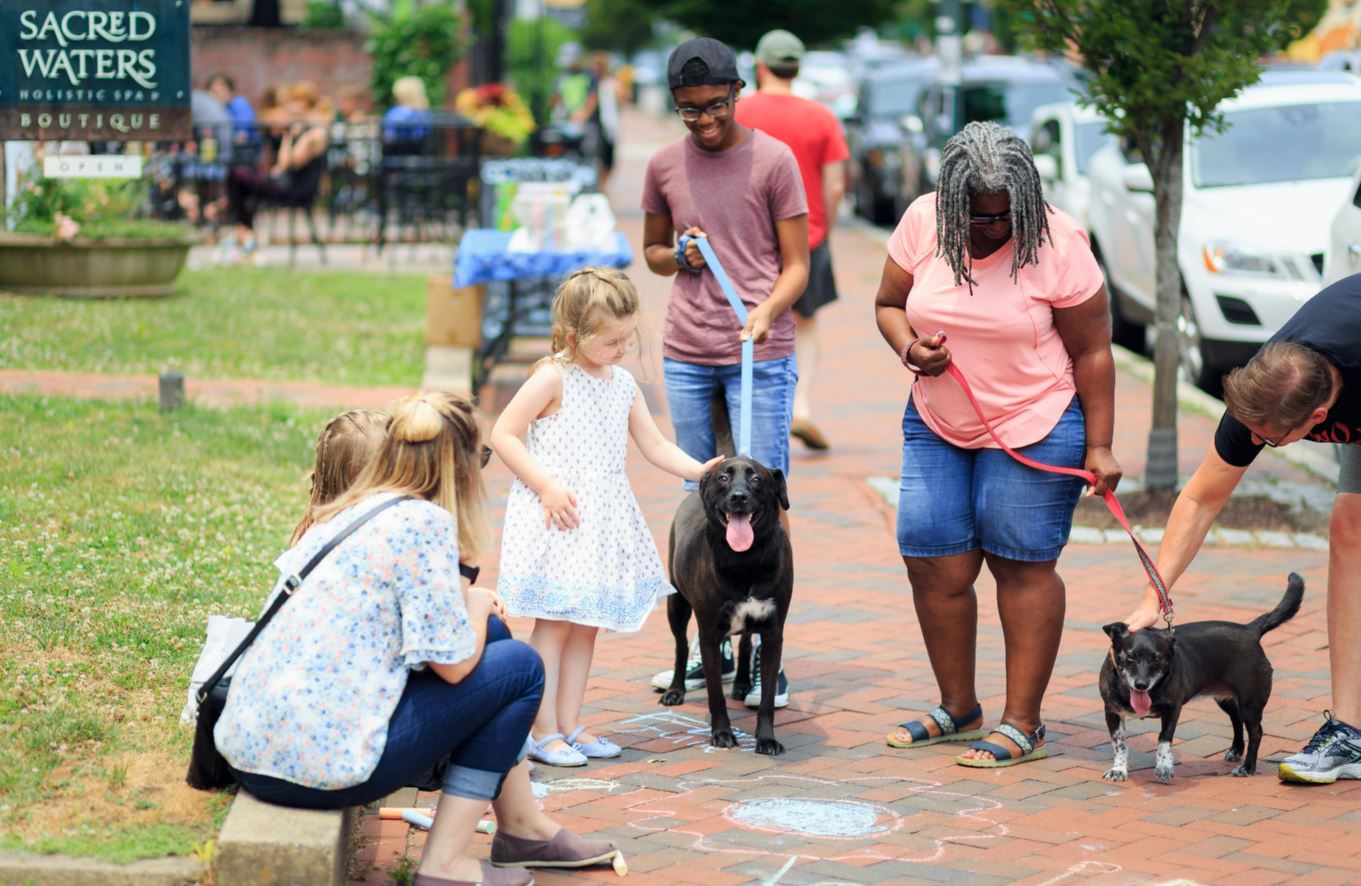
Introducing your puppy to a variety of people, animals, and environments is essential for their development and well-being. Start by gradually exposing your puppy to new experiences.
Begin with controlled settings like your home or backyard before venturing out.
Next, arrange puppy playdates with friends or neighbors who’ve well-behaved dogs.
This allows your puppy to learn social cues and proper play behavior in a familiar environment. Make sure all interactions are supervised to prevent any negative experiences.
Once your puppy is comfortable, take them to dog parks. These are excellent for socializing, but be cautious. Choose off-peak hours initially to avoid overwhelming your puppy with too many dogs at once.
Keep a close eye on their body language; if they seem anxious or scared, it’s okay to take a break and try again later.
In addition to dog parks and playdates, introduce your puppy to different environments like busy streets, quiet parks, and even pet-friendly stores.
This helps them become well-adjusted and confident in various situations.
Always carry treats to reward positive behavior and make these experiences enjoyable.
Crate Training Tips
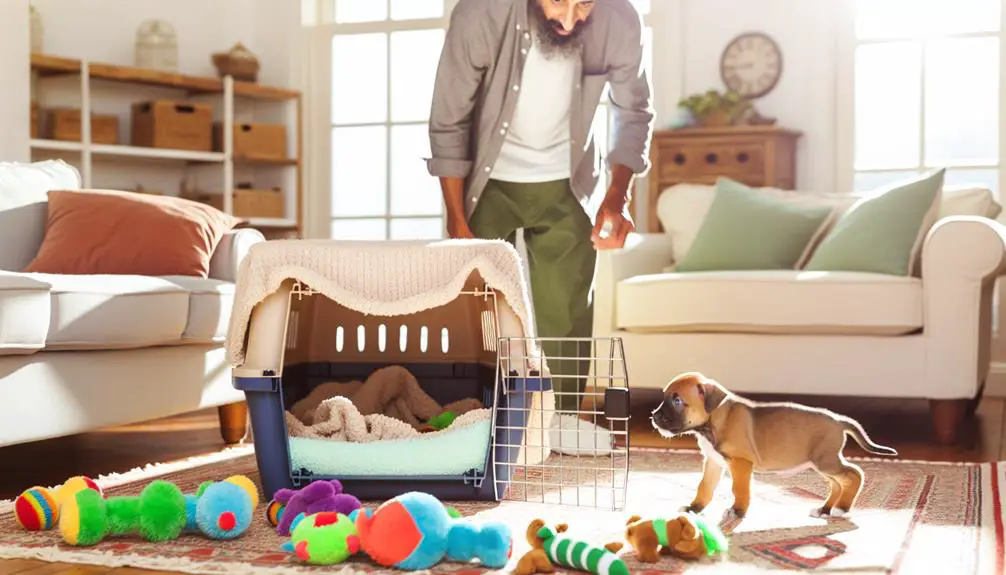
To start crate training, first choose the right crate that’s comfortable and safe for your puppy.
Next, establish a consistent routine to help your puppy understand when it’s time to rest.
Use positive reinforcement techniques to make the crate a welcoming space.
Choosing the Right Crate
Selecting the perfect crate for your puppy is essential for effective training and their overall comfort.
The first step is to choose the right crate size.
Your puppy should be able to stand up, turn around, and lie down comfortably. Too big, and they might use one end as a bathroom; too small, and it’ll be uncomfortable.
Next, consider crate placement.
Position the crate in a high-traffic area of your home, like the living room, so your puppy doesn’t feel isolated. They should see you and feel part of the family activities.
At night, you may wish to move the crate to your bedroom to keep an eye on them and provide comfort.
Here are three important points to keep in mind:
- Crate Size: Make sure the crate is just large enough for your puppy to move comfortably but not so large that they can relieve themselves in a corner.
- Crate Placement: Place the crate in a busy area during the day to keep your puppy engaged.
- Crate Type: Choose between wire crates for visibility and ventilation, or plastic crates for a den-like atmosphere.
Establishing a Routine
Once you’ve chosen the right crate, it’s important to establish a consistent routine to make crate training successful. Start by setting a regular schedule for meals, playtime, and naps.
This structure helps your puppy know what to expect and reduces anxiety.
First, designate specific times for meals every day and always feed your puppy in the crate. This will create a positive association with the crate. After meals, take your puppy outside for a bathroom break.
Next, establish a playtime structure. This involves scheduling multiple play sessions throughout the day.
Playtime should be energetic and engaging, helping your puppy expend energy and reducing the chance of destructive behavior.
Following playtime, allow your puppy a short bathroom break before returning them to the crate for a nap.
Nap scheduling is essential. Puppies need plenty of rest, so make sure your puppy has several scheduled naps in the crate throughout the day. This reinforces the crate as a safe, relaxing space.
Keep the crate in a quiet area where your puppy can nap undisturbed. Stick to the routine consistently, and soon enough, your puppy will adapt, making crate training much easier.
Positive Reinforcement Techniques
Incorporate positive reinforcement techniques to make crate training an enjoyable and effective experience for your puppy. Start by creating a welcoming environment inside the crate.
Use reward systems to encourage your puppy to enter and stay in the crate willingly. Clicker training can be an excellent tool to mark good behavior and help your puppy understand what’s expected.
Here’s a step-by-step approach:
- Introduce the Crate Gradually: Place the crate in a common area and keep the door open. Use treats and toys to entice your puppy inside. Each time your puppy enters the crate, click your clicker and immediately offer a treat.
- Increase Crate Time Slowly: Once your puppy is comfortable entering the crate, start closing the door for short periods. Use positive reinforcement by rewarding your puppy with treats and praise whenever they remain calm.
- Establish a Routine: Consistency is key. Use the crate during meal times and gradually extend the duration your puppy spends inside. Always use clicker training to signal the end of crate time, reinforcing that good things happen when they’re patient.
Positive Reinforcement Techniques

Using positive reinforcement techniques, you’ll effectively teach your puppy desired behaviors by rewarding them immediately after they perform a good action.
Start with a well-defined reward system. Choose treats your puppy loves or use toys and praise.
Begin by introducing clicker training, which involves using a small device that makes a clicking sound. Each time your puppy performs the desired behavior, click the device and immediately give them a treat.
This creates a clear association between the action and the reward.
Next, be consistent with your commands and rewards. For instance, if you’re teaching your puppy to sit, use the word ‘sit’ each time. When they comply, click and reward.
Over time, your puppy will understand that sitting on command earns them a treat.
Ensure you reward promptly. Delayed rewards can confuse your puppy, making it harder for them to link the behavior with the reward.
Lastly, gradually phase out the treats as your puppy masters the behavior, but continue using praise and affection to reinforce their good actions.
By following these steps, you’ll foster a positive learning environment, making training enjoyable and effective for both you and your puppy.

Frequently Asked Questions
To stop your puppy from chewing on furniture, use chewing deterrents like bitter spray. Apply it to the furniture for protection. Provide plenty of chew toys as alternatives, and supervise closely to reinforce good behavior.
The best toys for your puppy are interactive puzzles and squeaky balls—they’ll be your dog’s absolute favorite! Start with interactive puzzles to challenge their mind, then introduce squeaky balls for endless fun and engagement.
Check if your puppy appears relaxed and content after playtime. Confirm exercise duration fits their age and breed, and include activity variety like walks, fetch, and training games to keep them engaged and healthy.
For peak health, feed your puppy a diet with nutritional balance. Make sure high-quality protein sources like chicken, fish, or beef are included. Include essential vitamins and minerals. Always consult your vet to tailor the diet to your puppy’s needs.
Imagine you’re a knight preparing your puppy for independence. Start with crate training to create a safe space. Use calming techniques like soft music or a worn shirt. Gradually increase alone time to build their confidence.
Key Takeaways
- Establish a consistent bathroom routine using a specific spot outside for potty breaks.
- Set a strict feeding schedule with proper portioning and monitor eating habits.
- Start with basic commands like ‘sit’, ‘stay’, and ‘come’, using clicker training and positive reinforcement.
- Introduce the puppy to various people, animals, and environments to promote socialization.
- Use crate training techniques by gradually increasing crate time and making it a positive and comfortable space.
